Catechol-Based Porous Organic Polymers for Effective Removal of Phenolic Pollutants from Water
Abstract
1. Introduction
2. Materials and Methods
2.1. Materials
2.2. Polymer Synthesis
2.3. Characterization
2.4. Batch Adsorption Experiments
2.5. Adsorption Cycling Experiments
2.6. Adsorption Mechanism
3. Results and Discussion
3.1. Characterization of the Adsorbents
3.2. Batch Adsorption Experiments
3.3. Adsorption Kinetics
3.4. Adsorption Isotherms
3.5. Adsorption Cycling
3.6. Adsorption Mechanism
4. Conclusions
Supplementary Materials
Author Contributions
Funding
Institutional Review Board Statement
Data Availability Statement
Acknowledgments
Conflicts of Interest
References
- Huggins, X.; Gleeson, T.; Kummu, M.; Zipper, S.C.; Wada, Y.; Troy, T.J.; Famiglietti, J.S. Hotspots for Social and Ecological Impacts from Freshwater Stress and Storage Loss. Nat. Commun. 2022, 13, 439–449. [Google Scholar] [CrossRef]
- Gleick, P.H.; Cooley, H. Freshwater Scarcity. Annu. Rev. Environ. Res. 2021, 46, 319–348. [Google Scholar] [CrossRef]
- Mulcahy, E. Too Little Effort in Tackling Pollution Is Resulting in Too Many Lives Being Lost. BMJ 2022, 377, 1481–1482. [Google Scholar] [CrossRef]
- Cao, X.T.; Wang, K.; Feng, X.S. Removal of Phenolic Contaminants from Water by Pervaporation. J. Membr. Sci. 2021, 623, 119043–119058. [Google Scholar] [CrossRef]
- Panigrahy, N.; Priyadarshini, A.; Sahoo, M.M.; Verma, A.K.; Daverey, A.; Sahoo, N.K. A Comprehensive Review on Eco-Toxicity and Biodegradation of Phenolics: Recent Progress and Future Outlook. Environ. Technol. Innov. 2022, 27, 102423–102454. [Google Scholar] [CrossRef]
- Li, K.J.; Yang, Y.; Bacha, A.U.R.; Feng, Y.Q.; Ajmal, S.; Nabi, I.; Zhang, L.W. Efficiently Complete Degradation of 2,4-DCP Using Sustainable Photoelectrochemical Reduction and Sequential Oxidation Method. Chem. Eng. J. 2019, 378, 122191–122201. [Google Scholar] [CrossRef]
- Lu, S.C.; Liu, Q.L.; Han, R.; Guo, M.; Shi, J.Q.; Song, C.F.; Ji, N.; Lu, X.B.; Ma, D.G. Potential Applications of Porous Organic Polymers as Adsorbent for the Adsorption of Volatile Organic Compounds. J. Environ. Sci. 2021, 105, 184–203. [Google Scholar] [CrossRef] [PubMed]
- Garba, Z.N.; Zhou, W.M.; Lawan, I.; Xiao, W.; Zhang, M.X.; Wang, L.W.; Chen, L.H.; Yuan, Z.H. An Overview of Chlorophenols as Contaminants and Their Removal from Wastewater by Adsorption: A Review. J. Environ. Manag. 2019, 241, 59–75. [Google Scholar] [CrossRef]
- Li, X.; Huang, G.H.; Chen, X.J.; Huang, J.; Li, M.N.; Ying, J.N.; Liang, Y.; Yao, Y.; Li, Y.P. A Review on Graphitic Carbon Nitride (g-C3N4) Based Hybrid Membranes for Water and Wastewater Treatment. Sci. Total Environ. 2021, 792, 148462–148481. [Google Scholar] [CrossRef]
- Liu, Y.L.; Zhu, J.Y.; Zheng, J.F.; Gao, X.Q.; Tian, M.M.; Wang, X.M.; Xie, Y.F.; Zhang, Y.T.; Volodin, A.; Bruggen, B.V.D. Porous Organic Polymer Embedded Thin-Film Nanocomposite Membranes for Enhanced Nanofiltration Performance. J. Membr. Sci. 2020, 602, 117982–117989. [Google Scholar] [CrossRef]
- Ren, Y.L.; Zhu, J.Y.; Cong, S.Z.; Wang, J.; Bruggen, B.V.D.; Liu, J.D.; Zhang, Y.T. High Flux Thin Film Nanocomposite Membranes Based on Porous Organic Polymers for Nanofiltration. J. Membr. Sci. 2019, 585, 19–28. [Google Scholar] [CrossRef]
- Chen, K.F.; Hao, S.L.; Lyu, H.; Luo, G.; Zhang, S.C.; Cheng, J.M. Ion Exchange Separation for Recovery of Monosaccharides, Organic Acids and Phenolic Compounds from Hydrolysates of Lignocellulosic Biomass. Sep. Purif. Technol. 2017, 172, 100–106. [Google Scholar] [CrossRef]
- Li, B.Y.; Zhang, Y.N.; Ma, D.X.; Xing, Z.Y.; Ma, T.L.; Shi, Z.; Jin, X.L.; Ma, S.Q. Creation of a New Type of Ion Exchange Material for Rapid, High-Capacity, Reversible and Selective Ion Exchange without Swelling and Entrainment. Chem. Sci. 2016, 7, 2138–2144. [Google Scholar] [CrossRef]
- Zhang, Z.Y.; Hu, W.J.; Ruan, W.J.; Ai, H.Y.; Yuan, B.L.; Fu, M.L. Highly Improved Dechlorination of 2,4-Dichlorophenol in Aqueous Solution by Fe/Ni Nanoparticles Supported by Polystyrene Resin. Chemosphere 2021, 266, 128976–128983. [Google Scholar] [CrossRef]
- Zimmermann, K.; Wright, J.; Bérubé, P.; Barbeau, B.; Mohseni, M. Biological Ion Exchange Capable of Sulphate-Based Secondary Ion Exchange during Long-Term DOC Removal. Water Res. 2021, 196, 117036–117043. [Google Scholar] [CrossRef]
- Wu, S.H.; Liu, H.Y.; Lin, Y.; Yang, C.P.; Lou, W.; Sun, J.T.; Du, C.; Zhang, D.M.; Nie, L.J.; Yin, K.; et al. Insights into Mechanisms of UV/Ferrate Oxidation for Degradation of Phenolic Pollutants: Role of Superoxide Radicals. Chemosphere 2020, 244, 125490–125499. [Google Scholar] [CrossRef] [PubMed]
- Pei, S.Z.; Wang, Y.; You, S.J.; Li, Z.G.; Ren, N.Q. Electrochemical Removal of Chlorophenol Pollutants by Reactive Electrode Membranes: Scale-Up Strategy for Engineered Applications. Engineering 2022, 9, 77–84. [Google Scholar] [CrossRef]
- Hunge, Y.M.; Yadav, A.A.; Khan, S.; Takagi, K.; Suzuki, N.; Teshima, K.; Terashima, C.; Fujishima, A. Photocatalytic Degradation of Bisphenol A Using Titanium Dioxide@nanodiamond Composites under UV Light Illumination. J. Colloid. Interface Sci. 2021, 582, 1058–1066. [Google Scholar] [CrossRef]
- Hunge, Y.M.; Yadav, A.A.; Kang, S.-W.; Kim, H. Facile Synthesis of Multitasking Composite of Silver Nanoparticle with Zinc Oxide for 4-Nitrophenol Reduction, Photocatalytic Hydrogen Production, and 4-Chlorophenol Degradation. J. Alloys Compd. 2022, 928, 167133. [Google Scholar] [CrossRef]
- Domínguez, J.R.; Durán-Valle, C.J.; Mateos-García, G. Synthesis and Characterisation of Acid/Basic Modified Adsorbents. Application for Chlorophenols Removal. Environ. Res. 2022, 207, 112187–112193. [Google Scholar] [CrossRef] [PubMed]
- Zhou, L.C.; Meng, X.G.; Fu, J.W.; Yang, Y.C.; Yang, P.; Mi, C. Highly Efficient Adsorption of Chlorophenols onto Chemically Modified Chitosan. Appl. Surf. Sci. 2014, 292, 735–741. [Google Scholar] [CrossRef]
- Hu, H.T.; Miao, K.K.; Luo, X.L.; Guo, S.F.; Yuan, X.Q.; Pei, F.; Qian, H.M.; Feng, G.D. Efficient Fenton-like Treatment of High-Concentration Chlorophenol Wastewater Catalysed by Cu-Doped SBA-15 Mesoporous Silica. J. Clean. Prod. 2021, 318, 128632–128641. [Google Scholar] [CrossRef]
- Das, S.; Heasman, P.; Ben, T.; Qiu, S.L. Porous Organic Materials: Strategic Design and Structure–Function Correlation. Chem. Rev. 2017, 117, 1515–1563. [Google Scholar] [CrossRef]
- Xu, F.; Wu, D.C.; Fu, R.W.; Wei, B.Q. Design and Preparation of Porous Polymers. Chem. Rev. 2017, 20, 3959–4015. [Google Scholar] [CrossRef]
- Dawson, R.; Cooper, A.I.; Adams, D.J. Nanoporous Organic Polymer Networks. Prog. Polym. Sci. 2012, 37, 530–563. [Google Scholar] [CrossRef]
- Gong, W.T.; Deng, X.R.; Dong, K.X.; Liu, L.; Ning, G.L. A Boranil-Based Conjugated Microporous Polymer for Efficient Visible-Light-Driven Heterogeneous Photocatalysis. Polym. Chem. 2021, 12, 3153–3159. [Google Scholar] [CrossRef]
- Zhang, S.Y.; Gong, W.T.; Qv, W.D.; Deng, X.R.; Dong, K.X.; Zhang, S.Y.; Ning, G.L. Construction of Ionic Porous Organic Polymers (IPOPs) via Pyrylium Mediated Transformation. Chin. J. Polym. Sci. 2020, 38, 958–964. [Google Scholar] [CrossRef]
- Wu, Q.H.; Song, Y.H.; Wang, Q.Q.; Liu, W.H.; Hao, L.; Wang, Z.; Wang, C. Combination of Magnetic Solid-Phase Extraction and HPLC-UV for Simultaneous Determination of Four Phthalate Esters in Plastic Bottled Juice. Food Chem. 2021, 339, 127855–127863. [Google Scholar] [CrossRef] [PubMed]
- Shen, X.J.; Zhang, C.F.; Han, B.X.; Wang, F. Catalytic Self-Transfer Hydrogenolysis of Lignin with Endogenous Hydrogen: Road to the Carbon-Neutral Future. Chem. Soc. Rev. 2022, 51, 1608–1628. [Google Scholar] [CrossRef]
- Pińkowska, H.; Wolak, P.; Złocińska, A. Hydrothermal Decomposition of Alkali Lignin in Sub- and Supercritical Water. Chem. Eng. J. 2012, 187, 410–414. [Google Scholar] [CrossRef]
- Li, Y.D.; Shuai, L.; Kim, H.; Motagamwala, A.H.; Mobley, J.K.; Yue, F.X.; Tobimatsu, Y.; Havkin-Frenkel, H.; Chen, F.; Dixon, R.A.; et al. An “Ideal Lignin” Facilitates Full Biomass Utilization. Sci. Adv. 2018, 4, 2375–2548. [Google Scholar] [CrossRef]
- Liu, Y.L.; Zhou, X.; Jin, C.; Liu, G.F.; Liu, Z.S.; Kong, Z.W. Efficient and Rapid Removal of Typical Phenolic Compounds from Water with Biobased Porous Organic Polymers. Ind. Crops Prod. 2022, 184, 114971–114981. [Google Scholar] [CrossRef]
- Shao, L.S.; Liu, N.; Wang, L.Z.; Sang, Y.F.; Wan, H.N.; Zhan, P.; Zhang, L.; Huang, J.H.; Chen, J.N. Facile Preparation of Oxygen-Rich Porous Polymer Microspheres from Lignin-Derived Phenols for Selective CO2 Adsorption and Iodine Vapor Capture. Chemosphere 2022, 288, 132499–132509. [Google Scholar] [CrossRef]
- Xu, M.M.; An, Y.J.; Wang, Q.Q.; Wang, Z.; Zhou, J.H.; Wu, Q.H. Construction of Hydroxyl Functionalized Magnetic Porous Organic Framework for the Effective Detection of Organic Micropollutants in Water, Drink and Cucumber Samples. J. Hazard. Mater. 2021, 412, 125307–125319. [Google Scholar] [CrossRef]
- Huang, L.J.; Shuai, Q.; Hu, S.Z. Tannin-Based Magnetic Porous Organic Polymers as Robust Scavengers for Methylene Blue and Lead Ions. J. Clean. Prod. 2019, 215, 280–289. [Google Scholar] [CrossRef]
- Jiang, S.C.; Meng, X.F.; Xu, M.M.; Li, S.F.; Wang, Q.Q.; Liu, W.H.; Hao, L.; Wang, J.M.; Wang, C.; Wang, Z.; et al. Green Synthesis of Novel Magnetic Porous Organic Polymer for Magnetic Solid Phase Extraction of Neonicotinoids in Lemon Juice and Honey Samples. Food Chem. 2022, 383, 132599–132607. [Google Scholar] [CrossRef] [PubMed]
- Xu, M.M.; Wang, J.M.; Zhang, L.H.; Wang, Q.Q.; Liu, W.H.; An, Y.J.; Hao, L.; Wang, C.; Wang, Z.; Wu, Q.H. Construction of Hydrophilic Hypercrosslinked Polymer Based on Natural Kaempferol for Highly Effective Extraction of 5-Nitroimidazoles in Environmental Water, Honey and Fish Samples. J. Hazard. Mater. 2022, 429, 128288–128296. [Google Scholar] [CrossRef]
- Patil, N.; Jérôme, C.; Detrembleur, C. Recent Advances in the Synthesis of Catechol-Derived (Bio)Polymers for Applications in Energy Storage and Environment. Prog. Polym. Sci. 2018, 82, 34–91. [Google Scholar] [CrossRef]
- Xia, N.N.; Zhang, H.Y.; Hu, Z.Z.; Kong, F.G.; He, F. A Functionalized Bio-Based Material with Abundant Mesopores and Catechol Groups for Efficient Removal of Boron. Chemosphere 2021, 263, 128202–128211. [Google Scholar] [CrossRef] [PubMed]
- Zhang, S.P.; Li, Y.K.; Shi, C.H.; Guo, F.Y.; He, C.Z.; Cao, Z.; Hu, J.; Cui, C.Z.; Liu, H.L. Induced-Fit Adsorption of Diol-Based Porous Organic Polymers for Tetracycline Removal. Chemosphere 2018, 212, 937–945. [Google Scholar] [CrossRef]
- Modak, A.; Bhanja, P.; Bhaumik, A. Microporous Nanotubes and Nanospheres with Iron-Catechol Sites: Efficient Lewis Acid Catalyst and Support for Ag Nanoparticles in CO2 Fixation Reaction. Chem.-Eur. J. 2018, 24, 14189–14197. [Google Scholar] [CrossRef] [PubMed]
- Oladipo, A.C.; Tella, A.C.; Clayton, H.S.; Olayemi, V.T.; Akpor, O.B.; Dembaremba, T.O.; Ogunlaja, A.S.; Clarkson, G.J.; Walton, R.I. A Zinc-Based Coordination Polymer as Adsorbent for Removal of Trichlorophenol from Aqueous Solution: Synthesis, Sorption and DFT Studies. J. Mol. Struct. 2022, 1247, 131274. [Google Scholar] [CrossRef]
- Lv, X.; Li, S. Graphene Oxide–Crospolyvinylpyrrolidone Hybrid Microspheres for the Efficient Adsorption of 2,4,6-Trichlorophenol. ACS Omega 2020, 5, 18862–18871. [Google Scholar] [CrossRef]
- Huang, Q.; Chai, K.; Zhou, L.; Ji, H. A Phenyl-Rich β-Cyclodextrin Porous Crosslinked Polymer for Efficient Removal of Aromatic Pollutants: Insight into Adsorption Performance and Mechanism. Chem. Eng. J. 2020, 387, 124020. [Google Scholar] [CrossRef]
- Simsek, E.B.; Aytas, B.; Duranoglu, D.; Beker, U.; Trochimczuk, A.W. A Comparative Study of 2-Chlorophenol, 2,4-Dichlorophenol, and 2,4,6-Trichlorophenol Adsorption onto Polymeric, Commercial, and Carbonaceous Adsorbents. Desalination Water Treat. 2016, 57, 29488–29499. [Google Scholar] [CrossRef]
- Wang, Y.X.; Bi, Y.P.; Cui, Y.Y.; Yang, C.X. Synthesis of Crown Ether-Based Microporous Organic Networks: A New Type of Efficient Adsorbents for Chlorophenols. J. Hazard. Mater. 2023, 443, 130268. [Google Scholar] [CrossRef] [PubMed]
- Hu, X.; Xu, G.; Zhang, H.; Li, M.; Tu, Y.; Xie, X.; Zhu, Y.; Jiang, L.; Zhu, X.; Ji, X.; et al. Multifunctional β-Cyclodextrin Polymer for Simultaneous Removal of Natural Organic Matter and Organic Micropollutants and Detrimental Microorganisms from Water. ACS Appl. Mater. Interfaces 2020, 12, 12165–12175. [Google Scholar] [CrossRef]
- Yang, Z.; Zhang, Y.; Wang, X.Z.; Tian, Z.Q.; Yang, W.B.; Graham, N.J.D. Efficient Adsorption of Four Phenolic Compounds Using a Robust Nanocomposite Fabricated by Confining 2D Porous Organic Polymers in 3D Anion Exchangers. Chem. Eng. J. 2020, 396, 125296–125306. [Google Scholar] [CrossRef]
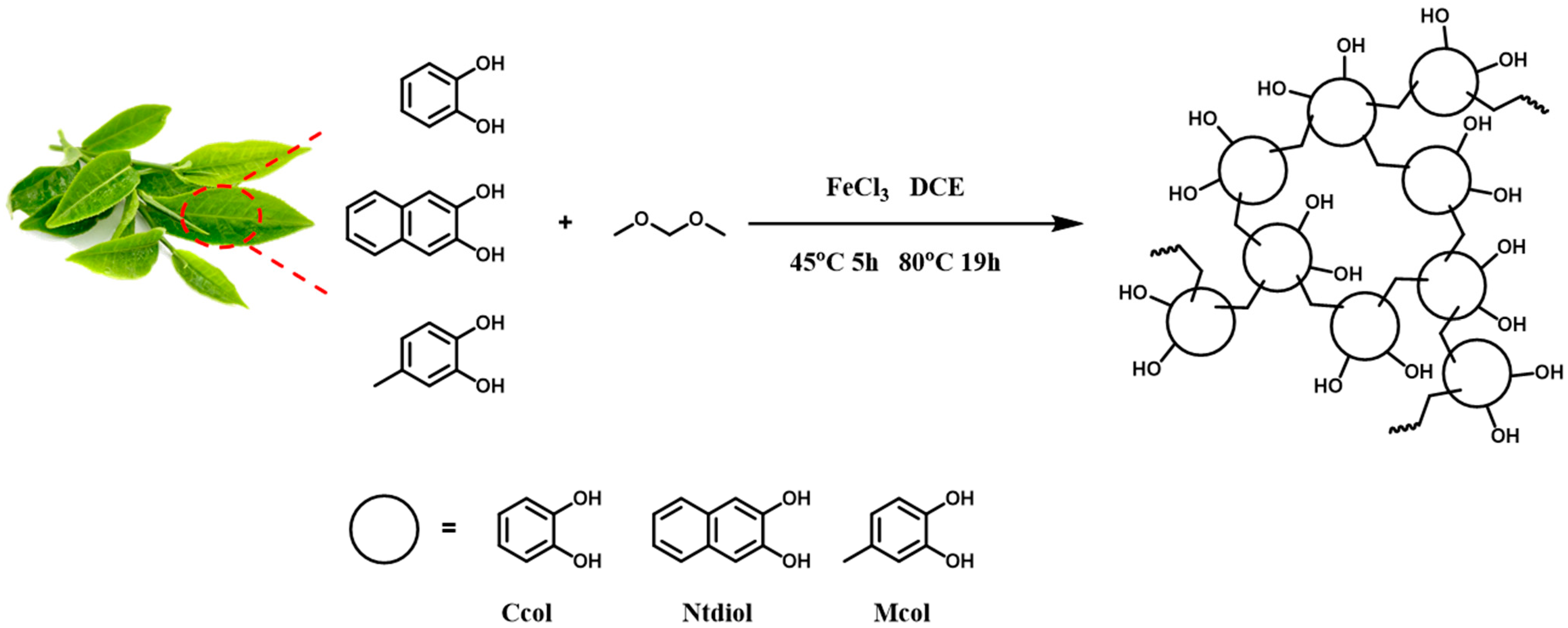
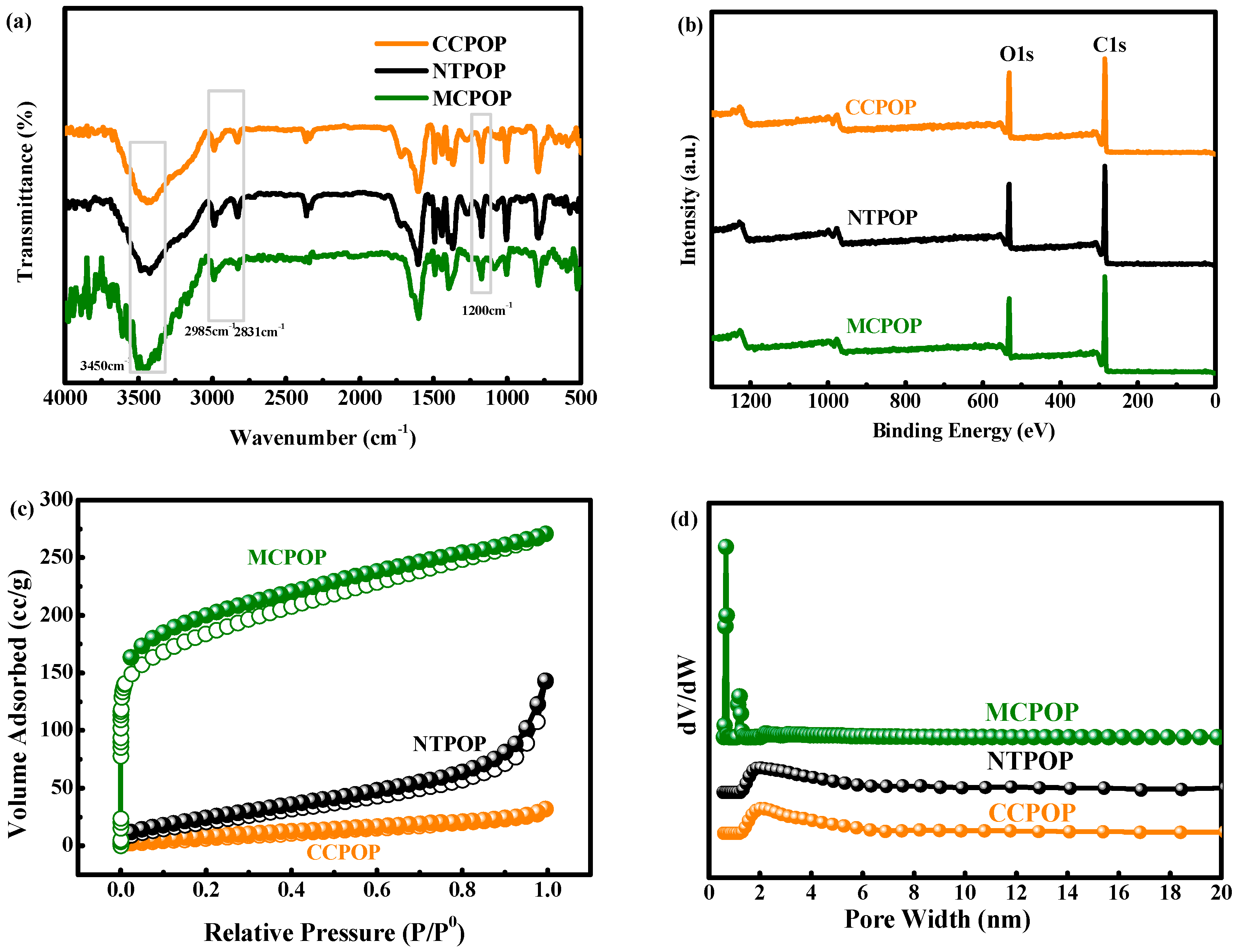
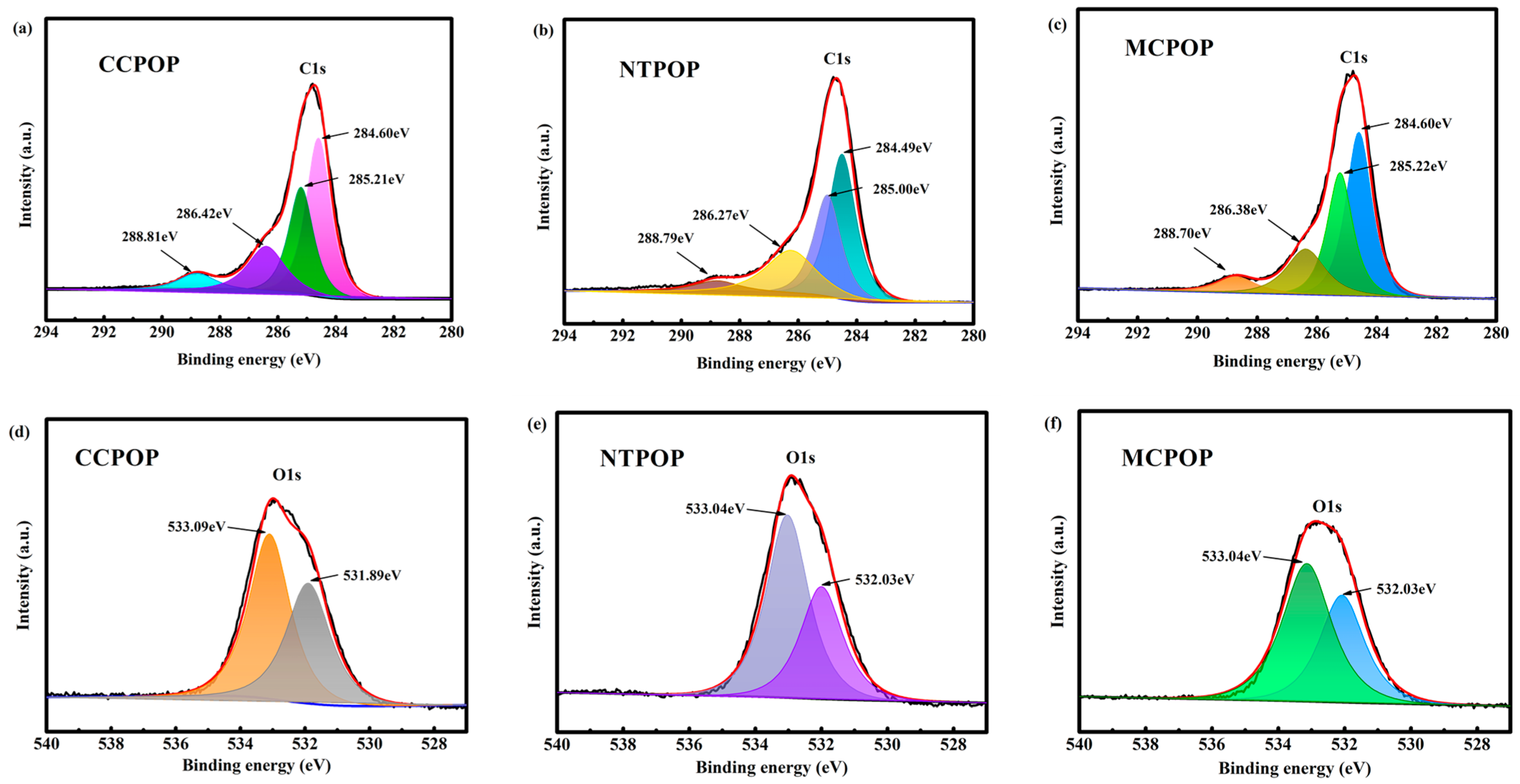

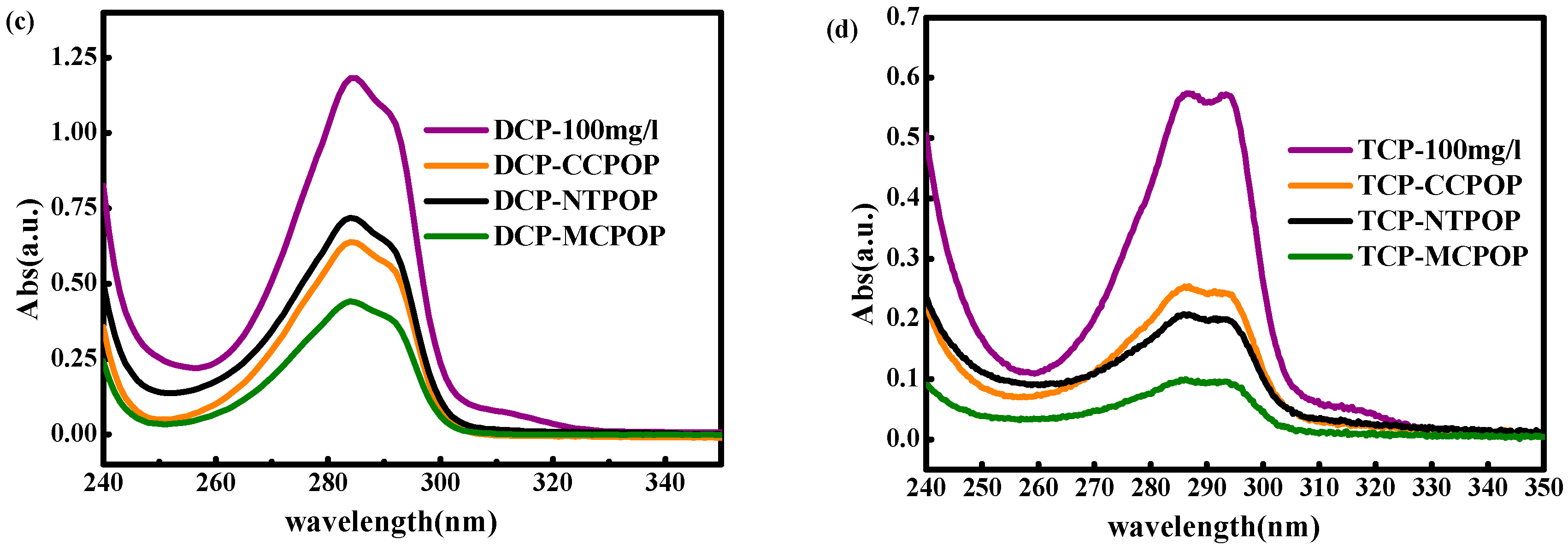




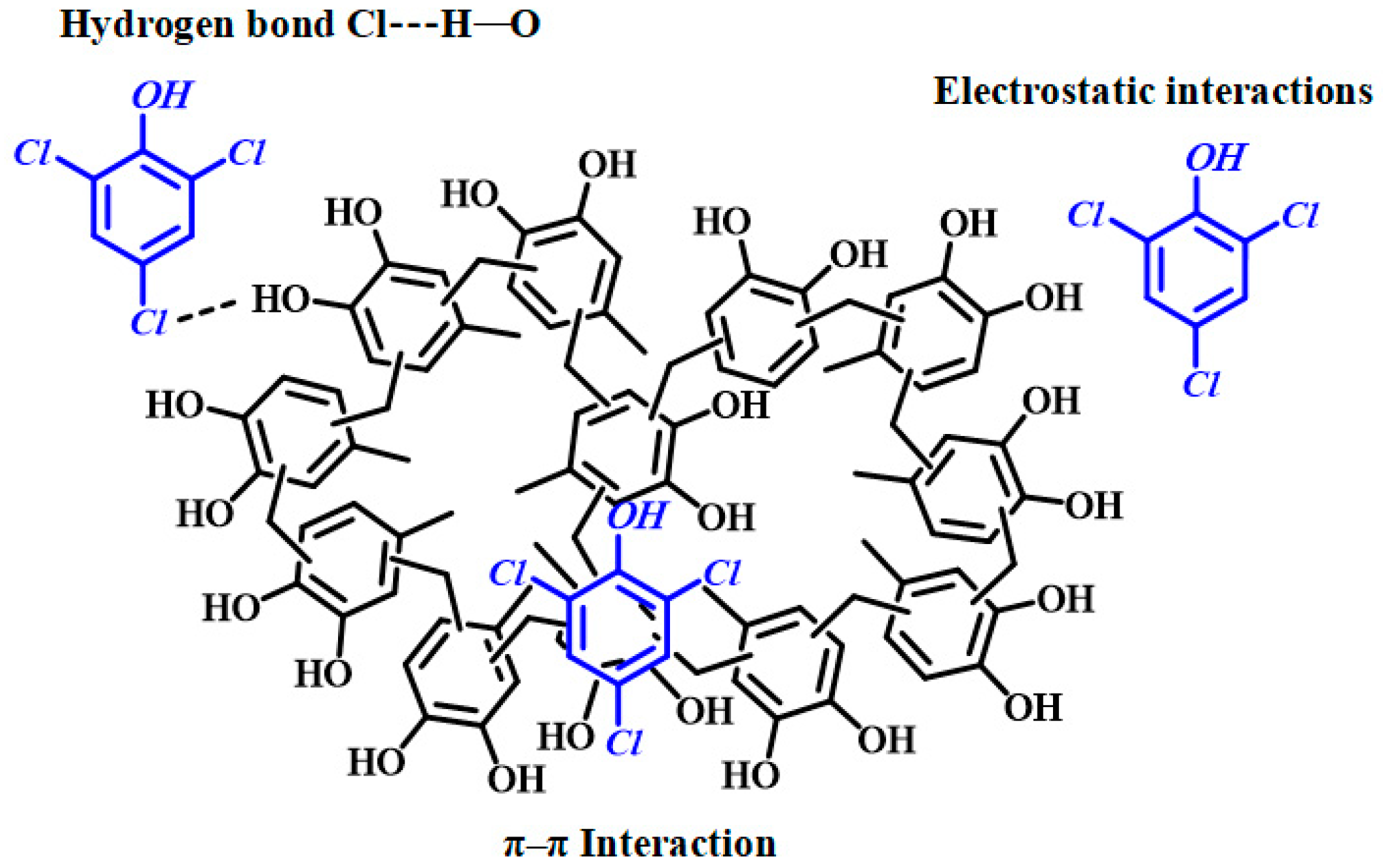
| Samples | SBET (m2/g) | VTotal (cm3/g) | Pore Size (nm) |
|---|---|---|---|
| CCPOP | 33.89 | 0.05 | 2.38 |
| NTPOP | 93.26 | 0.22 | 2.00 |
| MCPOP | 665.97 | 0.42 | 0.67 |
| Models | Parameters | CCPOP | NTPOP | MCPOP |
|---|---|---|---|---|
| Pseudo-first-order model | Qe (mg/g) | 167.9811 | 166.6401 | 316.5042 |
| k1 (min−1) | 0.0732 | 0.0746 | 0.1718 | |
| R2 | 0.9751 | 0.9950 | 0.9840 | |
| Pseudo-second-order model | Qe (mg/g) | 182.6841 | 180.6428 | 335.2129 |
| k2 (g·mg−1·min−1) | 5.7793 × 10−4 | 6.0143 × 10−4 | 7.7736 × 10−4 | |
| R2 | 0.9967 | 0.9978 | 0.9999 |
| Models | Parameters | CCPOP | NTPOP | MCPOP |
|---|---|---|---|---|
| Langmuir | Qm (mg/g) | 808.06 | 1195.30 | 1076.85 |
| KL (L/mg) | 0.0056 | 0.0039 | 0.0138 | |
| R2 | 0.9998 | 0.9927 | 0.9664 | |
| Freundlich | n | 0.6027 | 1.6035 | 0.4672 |
| KF [(mg·g−1)(mg·L−1)−1/n] | 17.2516 | 17.9525 | 68.5325 | |
| R2 | 0.9838 | 0.9991 | 0.9999 |
| Absorbents | Equilibrium Time (min) | Qm (mg/g) | References |
|---|---|---|---|
| [Zn(hba)2(tmdp)]n | 180 | 207.8 | [42] |
| GO-PVPP | 240 | 466.7 | [43] |
| TEPM-MON | 3 | 294.6 | [46] |
| β-CDP | 10 | 108.0 | [47] |
| PCD-PCP(L) | 150 | 816.5 | [48] |
| PCD-PCP(H) | 150 | 647.6 | [48] |
| CCPOP | 120 | 808.06 | This work |
| NTPOP | 120 | 1195.30 | This work |
| MCPOP | 60 | 1076.85 | This work |
Disclaimer/Publisher’s Note: The statements, opinions and data contained in all publications are solely those of the individual author(s) and contributor(s) and not of MDPI and/or the editor(s). MDPI and/or the editor(s) disclaim responsibility for any injury to people or property resulting from any ideas, methods, instructions or products referred to in the content. |
© 2023 by the authors. Licensee MDPI, Basel, Switzerland. This article is an open access article distributed under the terms and conditions of the Creative Commons Attribution (CC BY) license (https://creativecommons.org/licenses/by/4.0/).
Share and Cite
Zhao, X.; Liu, Y.; Zhu, Q.; Gong, W. Catechol-Based Porous Organic Polymers for Effective Removal of Phenolic Pollutants from Water. Polymers 2023, 15, 2565. https://doi.org/10.3390/polym15112565
Zhao X, Liu Y, Zhu Q, Gong W. Catechol-Based Porous Organic Polymers for Effective Removal of Phenolic Pollutants from Water. Polymers. 2023; 15(11):2565. https://doi.org/10.3390/polym15112565
Chicago/Turabian StyleZhao, Xiaoxiao, Yiqiong Liu, Qimeng Zhu, and Weitao Gong. 2023. "Catechol-Based Porous Organic Polymers for Effective Removal of Phenolic Pollutants from Water" Polymers 15, no. 11: 2565. https://doi.org/10.3390/polym15112565
APA StyleZhao, X., Liu, Y., Zhu, Q., & Gong, W. (2023). Catechol-Based Porous Organic Polymers for Effective Removal of Phenolic Pollutants from Water. Polymers, 15(11), 2565. https://doi.org/10.3390/polym15112565






